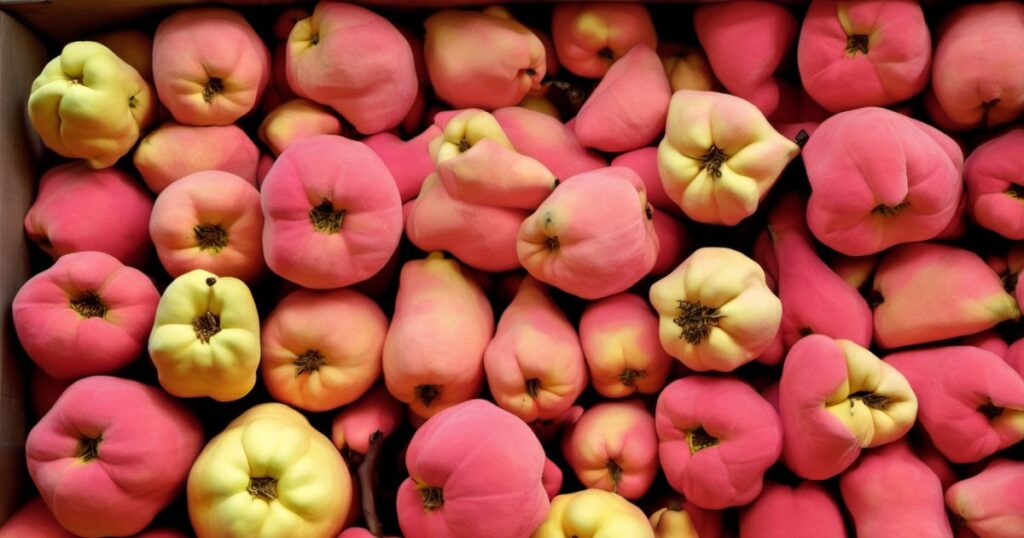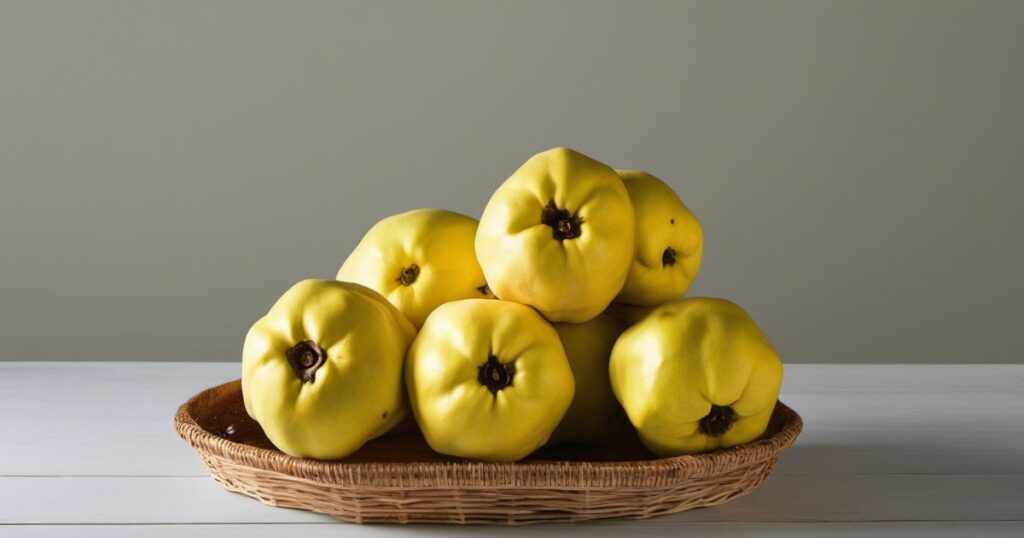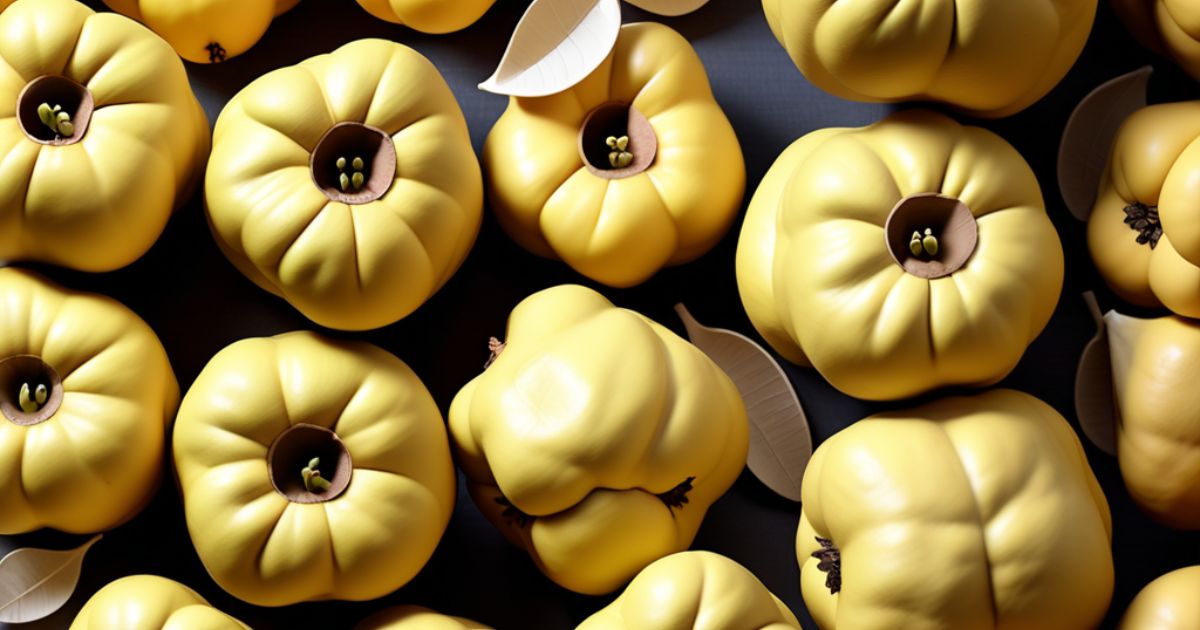Quince, a yellow fruit with a taste resembling a blend of apple and pear, is often underrated. Though its raw form is avoided due to its bitter flavor, when cooked, quince becomes a culinary gem.
From crumbles and chutneys to jams and the delightful Membrillo (quince paste), this fall fruit offers a versatile range of options. Typically in season from October to November, quince’s rock-hard flesh becomes a delectable treat after some culinary alchemy.
Undoubtedly, quince merits more attention as a unique fruit with a fascinating history. Despite its initially tough texture, cooking brings out its captivating aroma and flavor, making it a true seasonal delight.
Dive into the world of quince, exploring its taste, versatile applications, and enticing recipes. This often-overlooked fruit is worth a try, revealing its hidden charms and culinary potential this season.
WHAT IS QUINCE?
Quince is a flowering, deciduous tree that bears a fragrant, yellow fruit. It is a relative of the apple and pear. The fruit itself looks similar to a pear, but is much harder and sourer. Unlike other fruit, raw quince is too hard and astringent to eat. However, when cooked, quince transforms into something lush and sweet. As the flesh softens, juices are released and the flavor becomes incredibly aromatic. The resulting pinkish pulp is often described as a cross between apple, pear and rosewater.
Quince originated in the Middle East and Mediterranean, and has been cultivated there for thousands of years. It was prized by ancient Greeks and Romans. Quince remains popular in Europe, the Middle East, and some parts of South America. However, it is less well-known in North America. But interest in unique heirloom fruits like quince is on the rise. More specialty grocers now stock quince when in season.
WHEN IS QUINCE IN SEASON?

Quince ripens in the fall. The quince season runs from October through December in most regions. Shorter growing seasons mean some areas only see quince for a month or two. Quince is best eaten when fully ripe. Look for large, yellow fruits that yield to gentle pressure when ripe. A strong, sweet fragrance is another sign of ripeness. Store ripe quince at room temperature out of direct sunlight. It can keep for 1-2 weeks this way before cooking.
WHAT DOES QUINCE TASTE LIKE?
When raw, quince is astringent and tough. But once cooked, the pale yellow flesh turns rosy pink and takes on an amazing aroma and flavor. The taste is often described as a mix of apple, pear, and rosewater. Quince has more sugar and acidity compared to apple and pear, giving it a tarter, more complex flavor. When stewed or baked, quince takes on a rich, honeyed sweetness. It also pairs wonderfully with warm spices like cinnamon, vanilla and ginger.
Can You Eat Quince Raw?
No, quince should always be cooked before eating. The raw flesh is too hard, dry and astringent. Quince contains a compound called tannin that gives the unripe fruit an astringent, mouth-puckering quality.
Cooking helps break down tannins and starches, releasing the fruit’s juices and natural sweetness. After an hour or more of cooking, quince transforms into something truly delicious. Attempting to eat quince raw would be an unpleasant experience.
What Can You Use Instead of Quince?

If you can’t find quince, apples or pears make suitable substitutes in cooked dishes. Poached or baked apples can provide a similar soft, fragrant flesh. Opt for tart, firmer varieties like Granny Smith. Pears will also break down into a tender texture.
For an aromatic component, add lemon zest, vanilla, rosewater or ginger. While the flavor won’t be exactly the same, apple and pear can provide a pleasant result. You can also use citrus like oranges or tangerines in jams, chutneys and compotes.
6 THINGS TO DO WITH QUINCES
Once you get your hands on some quince, you’ll want to put them to good use. Here are six ways to make the most of the quince harvest.
Quince Jam
Turn quince into a sweet-tart jam. Cook chopped quince with sugar and lemon juice until softened and jammy. Quince jam makes a delicious filling for tarts, thumbprint cookies, crepes and more. Spread it on toast or crostini for breakfast.
Quince Chutney
Make a flavorful quince chutney to accompany Indian curries. Cook quince with typical chutney ingredients like onions, garlic, ginger, vinegar, brown sugar, raisins and warm spices. It’s excellent served with spicy chicken or lamb dishes.
Quince & Apple Crumble
For a simple dessert, make a quince and apple crumble. Stew quince and apples together with sugar and cinnamon, then top with a crunchy oat crumble mixture. Bake until golden brown and serve with ice cream or whipped cream.
Quince With Cheese
Try pairing cooked quince paste or jam with cheese. The fruit’s sweet-tart flavor goes wonderfully with salty cheeses like manchego or pecorino. Serve baked brie or camembert with quince jam on crackers for an easy appetizer.
Baked Quince
Baking intensifies quince’s rich flavor. Core and stuff quince halves with nuts, brown sugar and butter, then bake until tender. The stuffed quince halves make an elegant dessert served with whipped cream or ice cream.
Membrillo & Pate de Coings
Turn quince into membrillo or pâte de coing – thick quince pastes that are specialty products in Spain and France. Cook quince pulp down with sugar into a thick, sliceable paste that can be eaten as candy or with cheese.
Related Post: Pumpkin Carving Ideas
SEASONAL EATING WITH SAVERY GRAZING
Embrace seasonal produce like quince by signing up for a Savery Grazing subscription box. Each week’s box celebrates the current harvest with artfully curated fruits, vegetables, cheeses, baked goods and pantry items. Discover new seasonal flavors and easily incorporate them into your cooking with Savery’s inspired recipes. Experience the joy of cooking seasonally with deliveries straight from the Savery kitchen to your door.
FAQ’s
Can You Buy Quince in the UK?
Yes, quince can be purchased in the UK when in season from October to December. Many grocery stores like Waitrose, Tesco and Sainsbury’s carry quince. Farmers markets and farm shops are also good places to find quince grown locally in Britain. Online UK fruit delivery services may offer quince as well.
Do You Have To Cook Quince Before Eating?
Yes, quince should always be cooked first before eating. The raw fruit is too hard, dry and astringent to eat fresh. Cooking softens the flesh and transforms the flavor from harshly tannic to lushly sweet and aromatic. Quince requires slow cooking via baking, stewing or preserving into jams, chutneys, etc. After an hour or more of cooking, quince becomes deliciously edible.
Can You Freeze Quince?
Yes, you can freeze quince to enjoy later. Freeze ripe, raw quince for 8-12 months. Wash, peel, core and cut quince into slices or dice before freezing. Pack quince pieces in an airtight freezer bag or container, removing as much air as possible. You can also cook quince into jam, chutney, compote or paste, then freeze for 3-6 months. Frozen quince pulp or prepared recipes can be thawed in the fridge before using.
Final Thoughts on Enjoying Quince
Quince may seem intimidating at first with its tough, astringent flesh. But don’t be deterred by its raw state – when transformed by cooking, quince becomes an amazing fruit. Take the time to cook quince into jams, baked dishes, stuffings and cheese pairings to experience its floral aroma and rich, honeyed flavor.
Experiment with quince chutneys, compotes or pastes to enjoy year-round. Let quince lend its signature fragrance to your favorite apple pies or crisps. Next time you come across knobby, yellow quince in the fall, give this unique fruit a try. You’ll be delighted by how magical quince becomes when given the right preparation.











